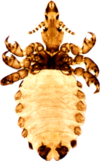midterm 2 (Arachonzoology) Flashcards

Chewing louse
(Goniodes dissimitis)
Bird louse

Chewing louse
(Menopon gallinae)

Chewing louse
(columbicola columbae)
Pigeon louse

Chewing louse
(felicola subrostratus)
Cat louse

Felicola nit

trichodectes nit

chewing louse
(trichodectes canis)

chewing louse
(bovicola bovis)

Werniquella equi

Blood sucking louse
(Haematopinus suis)
largest lice species to infest livestock

Blood sucking louse
(linognathus vituli)

Sucking louse
(Linognathus vituli)

Pulex irritans
Male on left smaller than female
Female on right has visible developing eggs on underside of abdomen

Ctenocephalides canis
Female on left
male on right

Ctenocephalides canis

ctenocephalides felis

bed bug
(Cimex lectularus )

Sand fly
(Psychoda spp.)
NON-PARASITIC
parallel veins of wings run without any cross veins

Sandfly
(Phelbotomus)
PARASITIC
long mouthparts and weak legs

Biting midge
(Ceratopognoid)
female on left
male on right

Mosquito
(Culex)
head of the female

Mosquito
(Culex spp.)
head of the male

Sandfly
(Phlebotomus)

Tabanus
species of horsefly



































































